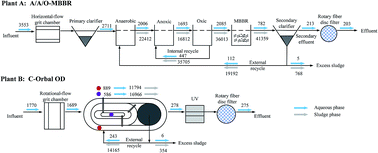Distribution, mass load and environmental impact of multiple-class pharmaceuticals in conventional and upgraded municipal wastewater treatment plants in East China†
Abstract
The occurrence, fate and environmental impact of 30 pharmaceuticals including sulfonamides, fluoroquinolones, tetracyclines, macrolides, dihydrofolate reductase inhibitors, β-blockers, antiepileptics, lipid regulators, and stimulants were studied in two municipal wastewater treatment plants (WWTPs) located in Wuxi City, East China. A total of 23 pharmaceuticals were detected in wastewater samples, with a maximum concentration of 16.1 μg L−1 (caffeine) in the influent and 615.5 ng L−1 (azithromycin) in the effluent; 19 pharmaceuticals were detected in sludge samples at concentrations up to 12.13 mg kg−1, with ofloxacin, azithromycin and norfloxacin being the predominant species. Mass balance analysis showed that biodegradation primarily accounted for the removal of sulfonamides, most of the macrolides, and other miscellaneous pharmaceuticals, while adsorption onto the sludge was the primary removal pathway for fluoroquinolones, tetracylines, and azithromycin during biological treatment. The total mass loads of target pharmaceuticals per capita in the two WWTPs were in the ranges of 2681.8–4333.3, 248.0–416.6 and 214.6–374.5 μg per day per inhabitant in the influent, effluent and dewatered sludge, respectively. The upgraded Plant A adopting the combined anaerobic/anoxic/oxic and moving bed biofilm process exhibited a much higher removal of target pharmaceuticals than the conventional Plant B adopting the C-Orbal oxidation ditch process. The concentration levels of sulfamethoxazole, ofloxacin, ciprofloxacin and clarithromycin in the effluent, ofloxacin in the sludge, and the mixture of all target pharmaceuticals in both effluent and sludge posed a high risk to algae in aquatic environments.


 Please wait while we load your content...
Please wait while we load your content...